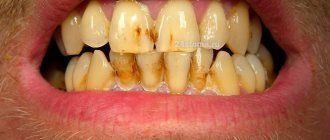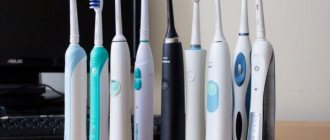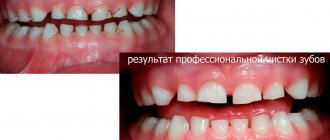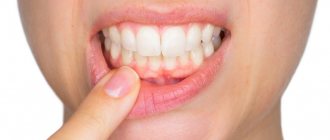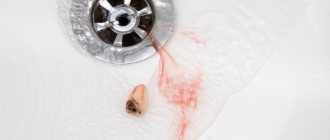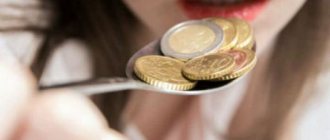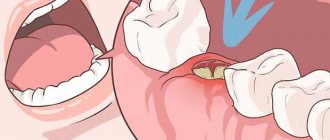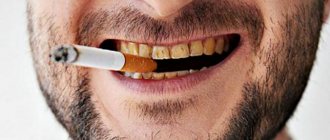Author of the article:
Soldatova Lyudmila Nikolaevna
Candidate of Medical Sciences, Professor of the Department of Clinical Dentistry of the St. Petersburg Medical and Social Institute, Chief Physician of the Alfa-Dent Dental Clinic, St. Petersburg
The appearance of yellow or dark plaque is a natural consequence of poor oral hygiene. Tea, coffee, smoking, and food pigments gradually stain the enamel of teeth. With proper cleaning, plaque is removed almost completely, but even under these conditions, contamination can be localized in hard-to-reach places, on the inner surface of the teeth, scratches and pits. As a result, stone formation is possible.
Eating is always favorable conditions for the appearance of plaque, since the porous carbon film on the surface of the teeth easily absorbs any coloring matter. Good toothpaste, proper care and periodic visits to the dentist will help maintain the natural color and health of your teeth. Let's talk about the main reasons for the appearance of tea plaque on teeth and ways to eliminate it.
Types of plaque on teeth
Tea is one of the most popular drinks in our country, so many people face the problem of plaque formation due to the use of this drink. The more fermented your tea is, the more likely it is that plaque will appear. Tannin, which gives the drink a bitter taste, also gives a dark tint, which actually remains on your teeth. In some cases, adding milk to tea will help avoid staining, but not everyone likes it.
If you notice that your teeth or your child’s teeth are turning yellow, remember that this may not only be a consequence of frequent tea drinking, but also evidence of dysbiosis and other troubles. In this case, the best solution would be to contact a specialist.
How to remove tea stains from teeth
There are many ways to remove plaque, all of which can be divided into professional and home ones.
It’s easy to deal with minor plaque on your own. Just remember that home remedies are not effective against old and very dark deposits.
Here it is better to consult a dentist; professional teeth cleaning 1-2 times a year can save you from many problems. To ensure that the result of care lasts for a long time, maintain it with a special paste.
There are several methods for removing plaque. One of the most popular is the use of a specialized Air-flow device, which creates a powerful stream of water. Abrasives are added to the liquid, which make it easy to remove deposits of any complexity. The procedure is usually performed without anesthesia.
Another option for professional care is ultrasonic cleaning, which can easily cope with even the densest plaque. After this procedure, the dentist polishes and grinds the surface of the teeth. The choice of method depends on the degree of contamination and your preferences.
Green tea
In general, all types of tea are obtained from the leaves of one plant. The only difference is the degree of processing. To obtain green varieties, the leaves are subjected to weak fermentation or not fermented at all, so they retain most of the beneficial substances: antioxidants, organic acids, various vitamins and minerals.
Briefly about green tea: 1. Used in traditional Indian and Chinese medicine. 2. Contains antioxidants, vitamins and beneficial microelements. 3. Helps normalize weight. 4. Slows down aging and improves the condition of skin, nails and hair. 5. Not suitable for people with high blood pressure. 6. Used in the prevention of serious diseases, including cancer. 7. Contains caffeine and can cause insomnia. 8. Stimulates brain function more gently and safely than coffee. 9. Has a diuretic effect. 10. The recommended norm is no more than three cups per day.
The effect of green tea on the health of teeth and gums
Drinking green tea daily reduces the risk of developing tooth decay, gum disease, and even oral cancer. The main thing is to drink the drink without added sugar, otherwise some of the beneficial effects will disappear.
Numerous studies have shown that green tea:
Prevents the development of caries. The main cause of tooth decay is bacteria living in plaque. They digest sugars from food and as a result produce lactic acid, which destroys tooth enamel. Green tea's antioxidants (catechins) inhibit bacterial activity, thereby reducing acidity in the mouth. Fluorides have an additional anti-caries effect, protecting tooth enamel from destruction.
Strengthens gum health. Catechins block the growth of bacteria that cause gum inflammation. This helps prevent gingivitis and periodontitis. In patients with established periodontitis who drink green tea daily, the disease progresses more slowly than in those who do not drink it. And their gum pockets are not so deep.
Green tea neutralizes sulfur compounds. These are specific volatile substances that are released by microorganisms living in the mouth. In its “deodorizing” ability, green tea is superior to mint, chewing gum and parsley essential oil. Reduces the risk of oral cancer. Green tea catechins have been shown to inhibit the growth of tumor cells and prevent the development of oral squamous cell carcinoma. This is the most common type of head and neck cancer.
“And how much green tea should you drink?”
Recommended dose: 3-4 cups per day. You should drink tea only when it is freshly brewed - in air, catechins gradually oxidize and the drink loses its beneficial properties. The brewing temperature should not exceed 85°C. Ratio of dry leaves to water: 3 g per 150 ml. Drinking more than 4 cups a day is not recommended, since green tea, like black tea, contains caffeine, which excites the nervous system and can cause insomnia.
https://zen.yandex.ru/media/roott/govoriat-zelenyi-chai-polezen-dlia-zubov-eto-pravda-5e6e60c658c7246c0e428f13 https://chaepedia.com/zelenii_chai/63-lechenie-zelenym-chaem.html https://style.rbc.ru/health/5f398a5b9a79477681abc25b https://www.ayzdorov.ru/tvtravnik_zelennii_chaii.php
Preventing tea stains on teeth
Tea lovers need to use a special whitening paste. A good option is to purchase ASEPTA PLUS, which provides gentle whitening and protection against plaque formation and unwanted pigmentation.
Advantages of ASEPTA PLUS paste:
- a unique multi-stage cleaning system that does not damage the enamel;
- content of potassium citrate and hydroxyapatite, which mineralize weakened enamel.
- calamus and eleutherococcus extracts strengthen the gums and help maintain healthy mucous membranes;
- Possibility of daily use.
Common questions about the properties of tea drinks
Is it possible to drink tea after tooth extraction?
Attention! Dentists do not recommend eating or drinking for 2 to 3 hours after tooth extraction due to the healing of the socket.
After this time, it is recommended to drink only cold drinks, since hot liquid can cause bleeding from the socket of an extracted tooth .
Does green tea protect your teeth?
Japanese dentists have found that this drink helps strengthen enamel and protect gums thanks to a large amount of fluoride and cahetin.
The components of the drink have anti-inflammatory and bactericidal properties , which prevents premature tooth loss.
Does green tea stain teeth?
Cosmetic dentists believe that excessive consumption of green tea can change the natural color of the enamel and turn it yellowish .
Important! The fact that teeth turn yellow is due to the high content of tannins, which enhance the coloring properties of the components.
To maintain a white smile, it is not recommended to drink the drink in excessive quantities.
Tea after filling
Depending on the filling technology and the composition of the material used, the filling can harden within several hours after the procedure or harden under the light of a special lamp immediately after installation. The danger of drinking tea after filling is the risk of staining the filling yellow or brown .
An amalgam filling
should not be exposed to dyes for 1–2 days , since during this time it undergoes a polymerization process.
Lamp treatment is typical for ceramic fillings.
This technology allows you to achieve the desired filling result without waiting and consume liquids and food almost immediately after the procedure.
Note! You should not drink hot drinks, as the new filling may become damaged and begin to crack under the influence of temperature.
Can tea whiten teeth?
Whitening properties are characteristic only of green and white teas , since, along with fluorine content, they contain practically no coloring molecules.
Tea after whitening
Dentists recommend abstaining from food and drinks for two hours after completing the whitening procedure.
After this period, the patient must go on a “White Diet” for up to two weeks.
The principle of the diet is to consume white foods or those that do not contain dyes in their composition.
At this time, only green and white teas are allowed to be consumed in small quantities.
Tea during teething
Teething is always accompanied by an inflammatory process. The antibacterial and anti-inflammatory properties of tea can facilitate the teething process and protect the child from oral infections .
Clinical researches
Clinical studies have proven that regular use of ASEPTA professional toothpaste improved the condition of the enamel by 64% and reduced tooth sensitivity by 66% after just 4 weeks.
Sources:
- Report on the determination/confirmation of the preventive properties of personal oral hygiene products “ASEPTA PLUS” Remineralization doctor-researcher A.A. Leontyev, head Department of Preventive Dentistry, Doctor of Medical Sciences, Professor S.B. Ulitovsky First St. Petersburg State Medical University named after. acad. I.P. Pavlova, Department of Preventive Dentistry
- Report on determining/confirming the preventive properties of toothpaste “ASEPTA PLUS” COFFEE and TOBACCO Author: doctor-researcher A.A. Leontyev, head Department of Preventive Dentistry, Doctor of Medical Sciences, Professor S.B. Ulitovsky. First St. Petersburg State Medical University named after. acad. I.P. Pavlova, Department of Preventive Dentistry
- Report on determining/confirming the preventive properties of toothpaste “ASEPTA PLUS” GENTLE WHITENING” Author: doctor-researcher A.A. Leontyev, head Department of Preventive Dentistry, Doctor of Medical Sciences, Professor S.B. Ulitovsky First St. Petersburg State Medical University named after. acad. I.P. Pavlova, Department of Preventive Dentistry
- Clinical and laboratory assessment of the influence of domestic therapeutic and prophylactic toothpaste based on plant extracts on the condition of the oral cavity in patients with simple marginal gingivitis. Doctor of Medical Sciences, Professor Elovikova T.M.1, Candidate of Chemical Sciences, Associate Professor Ermishina E.Yu. 2, Doctor of Technical Sciences Associate Professor Belokonova N.A. 2 Department of Therapeutic Dentistry USMU1, Department of General Chemistry USMU2
- Clinical studies of antisensitive toothpaste “Asepta Sensitive” (A.A. Leontyev, O.V. Kalinina, S.B. Ulitovsky) A.A. LEONTIEV, dentist O.V. KALININA, dentist S.B. ULITOVSKY, Doctor of Medical Sciences, Prof. Department of Therapeutic Dentistry, St. Petersburg State Medical University named after. acad. I.P. Pavlova
- The role of anti-inflammatory rinse in the treatment of periodontal diseases (L.Yu. Orekhova, A.A. Leontyev, S.B. Ulitovsky) L.Yu. OREKHOVA, Doctor of Medical Sciences, Prof., Head of Department; A.A. LEONTIEV, dentist; S.B. ULITOVSKY, Doctor of Medical Sciences, Prof. Department of Therapeutic Dentistry of St. Petersburg State Medical University named after. acad. I. P. Pavlova
Harm
Researchers around the world have conducted experiments to identify the negative aspects of green tea and its effect on teeth and gums . Scientists have concluded that any amount of drink consumed will not cause any harm to the oral cavity.
However, this conclusion does not apply to black tea.
Studies have found that the use of this variety leads to the rapid formation of a dark film on the surface of the tooth .
Regular consumption of the drink leads to darkening of tooth enamel, however, this can be avoided if you rinse your mouth with a special solution after each tea .
The beneficial properties of the drink directly depend on the quality of the product . Cheap tea bags are characterized by a high content of fluoride compounds. Their daily intake should not exceed 4 grams, since excess can harm teeth, bones and muscles.
How to get rid of yellow teeth
It is quite difficult to do this on your own. Without knowing the cause, you can cause even more harm. So, on the Internet you can find advice on applying soda slurry to cleanse yellow teeth. But this is a very aggressive way
, which should be used with caution, no more than once a week. Even so, there is a risk of developing stomatitis. The same can be said about citric acid and hydrogen peroxide. Complications from their use may outweigh the whitening effect.
Whitening pastes, strips or gels are safer. But they are not as effective as the methods used in dentistry. These include:
- Plaque removal
Air Flow procedures, laser and ultrasonic cleaning remove soft plaque, and with it light yellowing of the teeth. In this case, the enamel is not damaged, but the lightening effect is small.
- Professional whitening
You can clean yellow teeth in the dentist's office using gels, the action of which is activated as a result of chemical reactions or exposure to light. You can whiten yellow teeth up to 10 shades.
- Veneers
If it is not possible to clean yellow teeth, you can put thin ceramic onlays on them - veneers. To do this, the teeth are prepared and the top layer of enamel is removed. So, veneers are forever, you can’t refuse them, that’s why they are installed only for adults. But the aesthetic effect is very strong. The smile becomes radiant.
- Crowns
It is best to disguise the yellow color of teeth outside the smile zone with crowns. Modern composite materials are indistinguishable from natural enamel, and their strength is superior to natural fabrics.
If your teeth have turned yellow, the best advice is to visit your dentist. He will determine the causes and prescribe appropriate treatment.
Useful video
From this video you will learn how long after you can eat and drink after tooth extraction:
Tea is considered the safest drink for teeth, since only its excessive consumption can lead to negative consequences in the form of discoloration of tooth enamel.
When purchasing a product, it is recommended to take into account its composition and duration of storage , since flavors and fruits in the composition have a different effect on the teeth, and the storage time of the product contributes to the accumulation of fluoride compounds in tea leaves.

